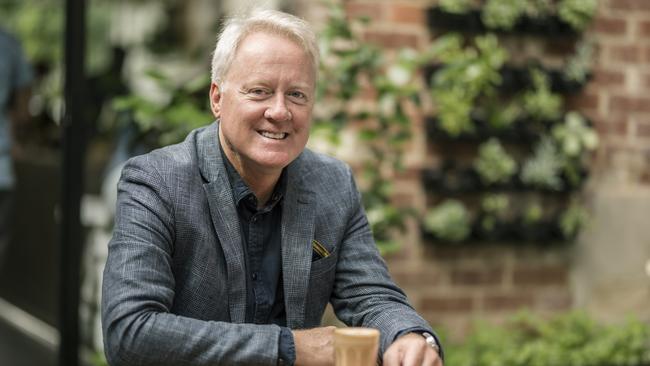Cafe Society: Connecting travellers with our culture
Mass visitation and Tasmania do not mix, says tourism boss John Fitzgerald.

Tasmania
Don't miss out on the headlines from Tasmania. Followed categories will be added to My News.
WHEN I worked at Vogue magazine in Sydney, we trotted out a standard line about our ideal reader’s mindset. “It’s not about an age, it’s about an attitude,” we chanted.
If she weren’t loaded, the Vogue woman sure as hell looked as if she were. When she travelled, it was in great style and her focus was on the finer things in life.
Wherever she went — and it probably wasn’t to Tassie — the sillage of her Chanel fragrance wafted in her wake.
The line comes back to me when I sit down with Tourism Tasmania chief executive John Fitzgerald the day after Vogue visits Hobart (in the form of editor-in-chief Edwina McCann) to attend the swishest fashion event probably ever held in Tasmania. And guess who was a prime mover of the deal to host the David Jones autumn/winter parade at Mona?
The smiling man sitting opposite me at Giddy Up Foodstore at Sandy Bay. John says the parade was a stunner. He needed his 16-year-old daughter to help him ID some of the famous visiting models on Instagram, though.
DAVID JONES LAUNCHES AUTUMN/WINTER LOOKS AT MONA
TOP MODELS LAUNCH DAVID JONES ART OF LIVING
As well as walking the runway, Gemma Ward, Jessica Gomes and Victoria Lee were part of a DJs Art of Living story curated to showcase the best of Tasmanian produce and fine fare along with the department store’s goods. Gorgeous imagery was shot around Hobart over several days (check out some of the highlights @davidjonesstore)
The DJs deal was the third fashion partnership with Tourism Tasmania over the past year or so, following brand alliances with Country Road and Witchery, which shot winter campaigns here last year.
“It is a great way of exposing winter in Tasmania to a different audience,” says John. “It’s using Tassie as a backdrop with brands that get to customers we want to connect with. Fashion gets the right audience and those connections are bearing such fruit for us.”
It hardly sounds like a mass tourism pitch, does it? And that’s the point John wants to make today. We are not that kind of destination and he gets that.
“It is certainly not our approach,” he says. “We target high-value travellers. Yes, we have seen super growth in the past five years [last year it was about 2 per cent], but it’s not a mass-tourism drive. We have always been particular.”
MORE CAFE SOCIETY:
NIALL DORAN: STRIVING TO INSPIRE YOUNG MINDS
CAROLINE SHARPEN: WE MUST ADD TO THE REPERTOIRE
GREG FRENCH: FLY-IN VENTURE THIN EDGE OF THE WEDGE
ERIN COLLINS: WE MUST SHARE THE LOVE, FOLKS
TIME FOR A LITTLE MORE CONVERSATION
The amount visitors are now spending exceeds even Tourism Tasmania’s targets, while volume is nicely in check. When John talks about the desirability of high-yield travellers, he doesn’t want to sound snobby.
“It’s not just about people with money,” he says. While “the erudites” — cultural tourists thus dubbed by marketers — spend up on short trips, “the raw urbanites” are likely to spend as much money over weeks’ long trips exploring the state. Both groups are welcome.
John believes Tasmanians are overwhelmingly supportive of the visitor economy.
“I see all these new businesses emerging and hear people saying their kids will now be able to stay on the island rather than leave,” he says. “The economic effects are vast. Think about the amenity provided to locals through the visitor economy.
“We wouldn’t have the restaurants, the chefs and all the new people having a crack that I see all over the state.”
He says the charter is to find the right customers, who will value who we are and contribute to our prosperity.
“Our vision is to connect people culturally and emotionally to Tasmania to deliver social and economic outcomes for Tasmanians,” he says. As well as its partnerships, Tourism Tasmania continues to run mainstream campaigns and they are looking ever-more distinctive.
“I think the future of tourism marketing looks less like tourism marketing and more like a mirror on the community,” says John.
“Because we are such an interesting place and there’s such a genuine connection of people to it over a very long time, it’s a really rich story. People travel for difference.
“Everybody talks about the Mona effect, but its biggest gift was the confidence it brought.”
The “people part” is the most important experience for tourists, he says.
Tasmanians themselves are the best advertisement for the place. Visitors want to feel welcomed by us.
“Going forward, it’s almost an invitation to people to experience what it’s like to be Tasmanian, to have a place on this island of abundance.”
Tourism Tasmania markets to their passion points.
“We used to target demographically by people’s ages, then it moved to attitudes,” he says, catapulting me back in time.
“But what the research is telling us is that travel is becoming a need. People need to escape the clutter of everyday life.
“What we are looking at is how Tasmania can fulfil that emotional need.”


